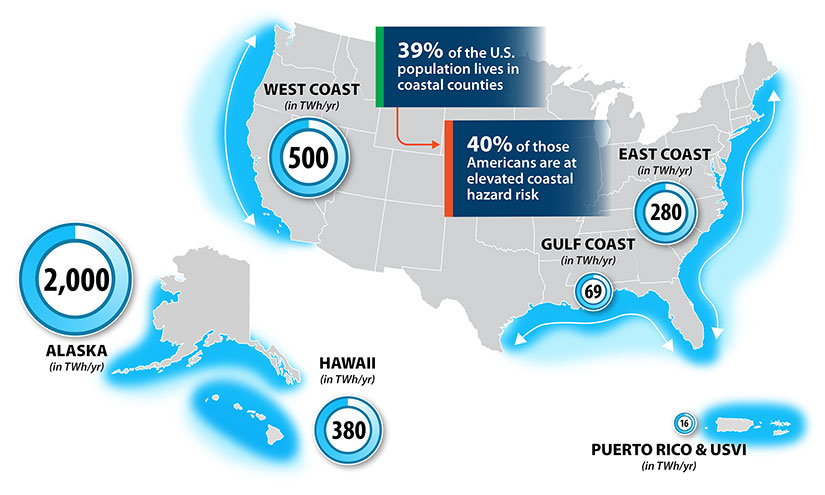Coastal Structure Integrated Wave Energy Converters
NREL researchers are working to accelerate the deployment of domestic coastal structure integrated wave energy converters (CSI WECs) so U.S. coastal communities can protect coastlines and produce clean, renewable energy.
Many types of wave energy converter technologies are in development around the world. Possibly the most successful form of this technology—CSI WECs—have been producing energy in other countries for many years, though CSI WECs are not yet in use in the United States.
What Is a Coastal Structure Integrated Wave Energy Converter?
CSI WECs are installed alongside a coastal structure, such as a breakwater, to protect vulnerable coastal communities from erosion and storms while converting wave energy into electricity. Because of the dual nature of the devices, CSI WECs can be viewed as a low-risk, high-reward endeavor.
Advantages of Coastal Structure Integrated Wave Energy Converters
The nearshore location of CSI WECs near shore means they are easier to operate and maintain than other forms of floating WECs, which are typically deployed further offshore. System maintenance can also be performed by a local workforce instead of highly specialized divers and marine operations teams. The nearshore location also reduces the need for extensive cabling for energy transmission—and locally produced energy can be supplied to the grid or used for a variety of applications such as desalination, ocean observation, and aquaculture.
Types of Coastal Structure Integrated Wave Energy Converters
Although a CSI WEC can be any wave energy converter that is either fully integrated into a coastal structure or mounted onto an existing structure, three types are most common:
- An oscillating water column features an air chamber that, when filled with water, creates pressure that spins a turbine to capture energy.
- A wall-mounted heave moves up and down with the waves to convert energy.
- An overtopping breakwater for energy conversion has a reservoir that fills up with water from oncoming waves. The trapped water is funneled back into the ocean through a small chamber, spinning an electricity-generating turbine along the way.

Powering our Coasts, Protecting our Communities
In the small town of Mutriku, Spain, a breakwater-embedded wave energy plant has provided renewable energy to the town for more than a decade. South Korea, India, Israel, and Italy have also installed CSI WECs that successfully generate energy from waves.
The United States, however, does not have any CSI WECs in operation, even though the devices could be installed now—unlike many WEC technologies that may still require years of research before deployment. Accelerating the installation of CSI WECs on U.S. coastlines could help the country lead in this marine energy space.
Near-Shore Energy Potential for Coastal Structure Integrated Wave Energy Converters

Capabilities
NREL's water power research team is working to develop the tools, methods, and processes to make CSI WEC deployment a near-term possibility in the United States. That entails efficient site screening and selection, technology assessment and development, techno-economic analysis, demand assessment, and engagement with industry leaders in the field.
The CSI WEC research project leverages the NREL water power team’s expertise in:
Resource characterization to develop site screening methodology
WEC design to engineer and test CSI WEC technologies
Techno-economic analysis to perform industrywide assessments of the levelized cost of marine energy.
Microgrid modeling and power hardware-in-the-loop validation to de-risk CSI WEC systems integration.
The team will also advise on high-impact CSI WEC deployment projects and provide guidance on site selection, the proposed type of CSI WEC, techno-economic strategy, a technology development pathway, and more. The team’s goal is to support the rapid development of CSI WECs in the United States.
Contact
Share

